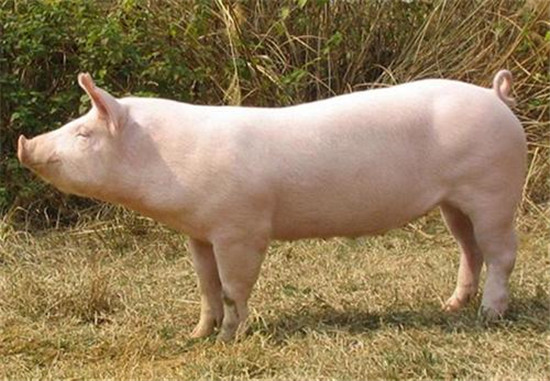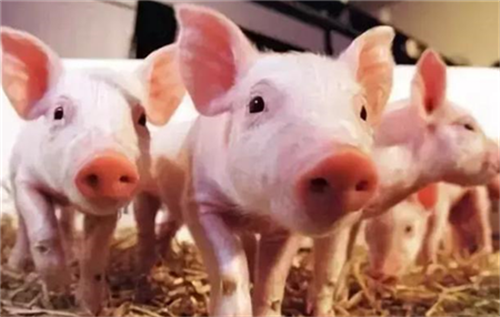Prevention and treatment of three kinds of common internal diseases in live pigs
1. Porcine gastroenteritis
Porcine gastroenteritis is a disease of severe inflammation in the surface and deep tissue of porcine gastrointestinal membrane. The disease is mainly caused by improper feeding and management of pigs, such as eating spoiled feed, toxic feed, or drinking unclean drinking water. If drugs are not used properly in the treatment of dyspepsia, the gastrointestinal wall can also be seriously stimulated, resulting in gastrointestinal absorption of a large amount of bacterial toxins, and then develop into gastroenteritis. In addition, malnutrition, long-distance transportation and abuse of antibiotics can cause the disease.
The main symptoms of the disease are elevated body temperature to 40-41 ℃, thin feces sticking to the anus and tail, sometimes fecal incontinence, rapid pulse, diarrhea, loss of appetite, dry mouth and tongue coating.
Diseased pork chops are soft or watery and mixed with blood; diseased pigs lose weight and dehydration, sunken eyeballs, and decreased skin elasticity can be found on hand touch. In the diagnosis, should pay attention to the difference with infectious diarrhea, if necessary to carry out autopsy, will find that the visual membrane is pale, there are changes in septicemia.

To treat this disease, first of all, when the pig is not dehydrated at the initial stage of the disease, take 50-100 ml of liquid paraffin to the water, so as to clean up the gastrointestinal tract. Secondly, take sulfamethoxazole 0.1-0.3 g / kg body weight for 2-3 times, or sulfamethoxazole 5-10 g and baking soda 2-3 g, twice a day, or oxytetracycline, 100 mg / kg body weight, once a day for 3-5 days, so as to achieve anti-inflammatory and antibacterial effect. If long-term dysentery occurs in diseased pigs, kneading acid protein and nitrous acid should be taken twice a day. At the same time, intestinal antibiotics such as gentamicin, dysentery, enrofloxacin and other intestinal antibiotics should be given according to dose, or medicinal charcoal should be selected for treatment. Thirdly, when the disease of diseased pigs is relieved, pepsin and lactase can be used to give birth to 10 grams of pepsin and 2 grams of sodium caffeine powder, which can be taken orally for 3 times after mixing to enhance the therapeutic effect and make the diseased pigs recover. Traditional Chinese medicine can be mashed into mud with garlic and taken orally with 20-30 ml of liquor at a time.
To prevent this disease, it is necessary to strengthen feeding and management, keep the pig house hygienic, dry, warm and ventilated, improve feed quality, do not feed moldy and deteriorated feed, keep drinking water clean, and do a good job in the prevention of other infectious and parasitic diseases. once it is found that pigs suffering from indigestion should be treated in time to prevent the disease from turning into gastroenteritis.
2. Dyspepsia
Indigestion in pigs is mainly caused by moldy and deteriorated feed on the surface of gastrointestinal mucosa, or stimulation of feed suddenly cold and hot, which leads to digestive dysfunction and decreased gastrointestinal digestion and absorption function. The disease can also be caused by improper feeding and management, such as oversatiety or hunger of pigs, excessive thirst and excessive drinking, and feeding immediately after long-distance transportation. In addition, if pigs accidentally ingest irritant drugs, it will also cause the disease by stimulating the gastrointestinal bowel membrane. The disease is generally divided into acute and chronic dyspepsia.
The main symptoms of the disease are loss of appetite, lethargy, slow chewing when eating, red-yellow or yellow-white oral membrane, enhanced intestinal sound, frequent vomiting or retching, and abdominal pain and distension in seriously ill pigs. There was no significant change in general body temperature of diseased pigs. In the diagnosis, it is necessary to integrate a variety of conditions to distinguish between stomach and small intestine for pig indigestion or large intestine-based dyspepsia. The main difference is that the former has heavy halitosis, thick tongue coating, near abolition of appetite, accompanied by vomiting and constipation, while the latter has soft or watery stool mixed with mucus and obvious intestinal sound.
The basic principle for the treatment of this disease is to remove the cause, improve diet, clear intestines and make yeast. First of all, it is necessary to check whether the feed is deteriorated, and at the same time change to feed which is easier to digest and nourish at full price, and give sufficient drinking water. Secondly, drug treatment can choose sodium sulfate or human salt to take an appropriate amount of water to clean up the stomach and intestines of diseased pigs and stop the contents from further fermentation. The dosage of sodium sulfate or human salt is 30-50 grams with appropriate amount of water. After clearing the intestines, the gastrointestinal function should be adjusted in time. 2-10 pieces of yeast tablets can be fed in the mixed feed twice a day. It can also be treated with traditional Chinese medicine, such as 3 grams of rhubarb powder, 1 gram of gentian powder, 10 grams of salt, mixed with oral administration twice for 3-5 days. If the diarrhea of sick pigs is serious, anti-inflammation and anti-diarrhea should be carried out. Dysentery (0.2-1g or berberine 0.2-0.5g) can be taken orally twice a day. If the sick pig is dehydrated, glucose solution and compound sodium chloride solution should be used to maintain body fluid balance.
To prevent this disease, it is necessary to strengthen feeding management, rational allocation of feed, to prevent feeding mildew deterioration and too much rough feed. The pigsty should be regularly buttoned and ventilated, and do a good job of keeping warm.
3. Intestinal constipation
Intestinal constipation is an abdominal pain disease caused by intestinal obstruction caused by intestinal relaxation and moisture absorption and dryness of the contents. The disease is the biggest obstacle in sow production, and constipation is common in perinatal sows. In addition, swine erysipelas, swine fever and other febrile infectious diseases will also be secondary to the disease.
The main symptoms of the disease are reducing and stopping eating, less dry defecation, bowel fluid, blood or exfoliated bowel membrane on the surface, and cylindrical or beaded dry hard dung balls can be touched by deep abdominal palpation. The body temperature increased in the middle and later stage of the disease, and the seriously sick pigs died. At the same time, the course of disease is longer, intestinal wall necrosis, can be complicated with localized peritonitis. The systemic symptoms of diseased pigs should be considered in the diagnosis.
To treat this disease, you should first stop feeding or only feed a small amount of green sweating feed and drink a lot of warm water at the same time. For pigs in good initial condition, use 30-80 grams of sodium sulfate or magnesium sulfate and 1000 milliliters of warm water, once. And use warm water, 2% baking soda or fat house water, repeated deep enema, combined with abdominal massage, generally effective. When you are in severe pain and restlessness, you can inject 30% analgesin nearly 10 milliliters, or take 5-10 grams of sodium aureate internally. When drug treatment is ineffective, laparotomy, enterotomy or enterectomy should be performed in time.
In order to prevent this disease, it is necessary to strengthen feeding management, set up Xiji feed reasonably, and ensure adequate drinking water and appropriate amount of exercise. Piglets just weaned cannot be fed with pure rice bran. (source: pig breeding auditorium)
- Prev

Why do pigs often vomit? What should I do?
Why do pigs often vomit? What should I do?
- Next

Sow constipation is harmful, the method of relieving constipation soil is rough, but the effect is good.
Sow constipation is harmful, the method of relieving constipation soil is rough, but the effect is good.
Related
- On the eggshell is a badge full of pride. British Poultry Egg Market and Consumer observation
- British study: 72% of Britons are willing to buy native eggs raised by insects
- Guidelines for friendly egg production revised the increase of space in chicken sheds can not be forced to change feathers and lay eggs.
- Risk of delay in customs clearance Australia suspends lobster exports to China
- Pig semen-the Vector of virus Transmission (4)
- Pig semen-the Vector of virus Transmission (3)
- Five common causes of difficult control of classical swine fever in clinic and their countermeasures
- Foot-and-mouth disease is the most effective way to prevent it!
- PED is the number one killer of piglets and has to be guarded against in autumn and winter.
- What is "yellow fat pig"? Have you ever heard the pig collector talk about "yellow fat pig"?

